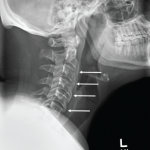I explained why I disagreed with his prior diagnosis of ankylosing spondylitis and how these prominent bony spurs were not likely causing his back pain. “They were just placed there to confuse your doctors,” I said. I recommended some simple stretching exercises and, if he was motivated, for him to try some physical therapy. He was so grateful! “Thank you doctor, I have been to so many doctors and you are the first one who explained what is wrong with my back and what I need to do about it.” He did not require any pain medication—or so I thought; about an hour later I realized that my prescription pad was missing. He must have had a fleeting opportunity to grab it when I turned my back to study his X-rays. So much for his so-called loss of mobility! Two days later a local pharmacy was paging me to confirm my “prescription” for 200 tablets of a brand name of oxycodone. The following day there was another call, but this time the prescription was for generic oxycodone.
A call to the state police confirmed that Mr. DISH had 22 other similar citations for what is euphemistically known in the Commonwealth of Massachusetts as “uttering a false prescription.” Such a grateful patient! I wondered whether he used this ruse of an abnormal-appearing spine X-ray to extract authentic narcotic prescriptions from unsuspecting physicians. After all, DISH isn’t supposed to be symptomatic, but I doubt that nonrheumatologists are aware of this fact.
For the next few weeks, I became obsessed with DISH. Maybe the shock of having to deal with my medical identity theft made me determined to learn all I could about this obscure condition. So what is DISH? Is it really just a radiographic phenomenon seen in older men carrying little, if any, clinical significance? Why does it develop in the first place? As I delved deeper into the topic, I came to realize that DISH is one of those arcane, truly fascinating rheumatologic conditions with a rich history that spans civilizations.
Did you know that pathognomonic osteophytesin DISH are almost always seen on the right side of the vertebra, except in cases of dextrocardia or situsinversus? Talk about a great trivia question for your next cocktail party!
Some Definitions
Jacques Forestier and Jaume Rotés Querol first described this radiographic finding in 1950 and termed it senile ankylosing hyperostosis of the spine. They defined it as “an ankylosing disease of the spine developing in old people with a painless onset and clinical, pathological, and radiological features distinguishing it from ankylosing spondylitis.” There were about six different names given to this condition before Donald Resnick, one of the great musculoskeletal radiologists, renamed the entity DISH and established diagnostic criteria requiring the involvement of at least four contiguous vertebrae of the thoracic spine with preservation of the intervertebral disc space and an absence of any apophysealor sacroiliac joint inflammatory changes. Nowadays, most clinicians consider DISH when they spot those pathognomonic osteophytes coursing over the anterolateral aspect of the thoracic spine. Did you know that they are almost always seen on the right side of the vertebra, except in cases of dextrocardia or situsinversus? Talk about a great trivia question for your next cocktail party!
Paleorheumatology
To learn more about DISH, we need to travel back to 15th-century Italy. Natale Villari and a group of researchers working at the Universities of Florence, Pisa, and Siena have studied the exhumed remains of the Medici family. The Medici was one of the richest and most powerful families of the Italian Renaissance. Beginning in the 14th century, through careful management of banking ventures and skillful political action, the family rose to the pinnacle of social and political power in the city of Florence in the Tuscany region of Italy, which the Medici made the intellectual center of the Western world for the next two centuries. Members who included Cosimo “the Elder,” Piero “the Gouty,” and Lorenzo “the Magnificent” were lovers of the arts and sciences and patrons of Michelangelo, da Vinci, Botticelli, and Galileo.

